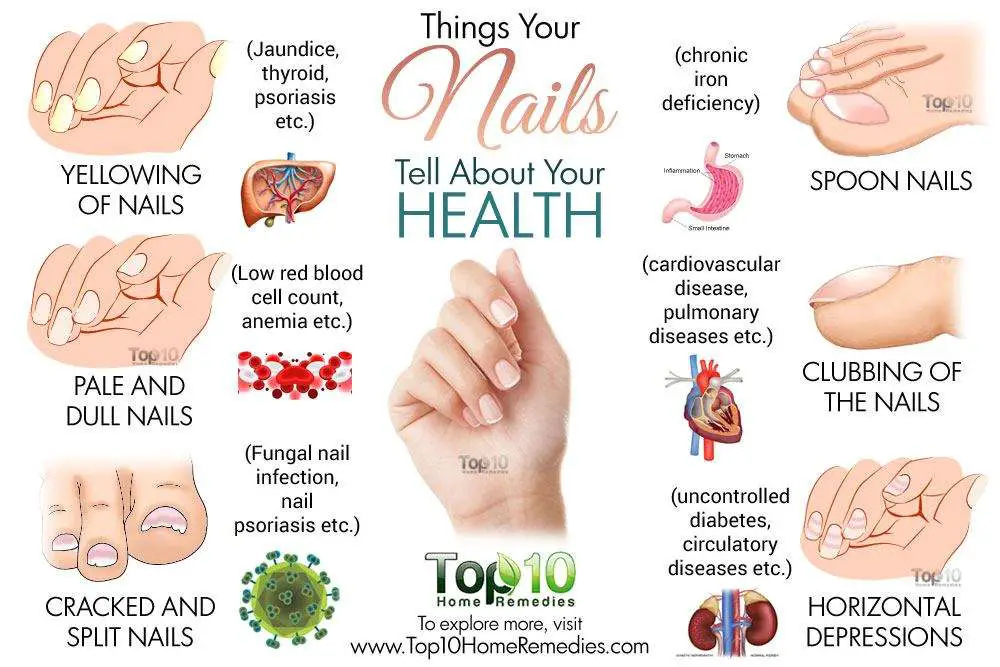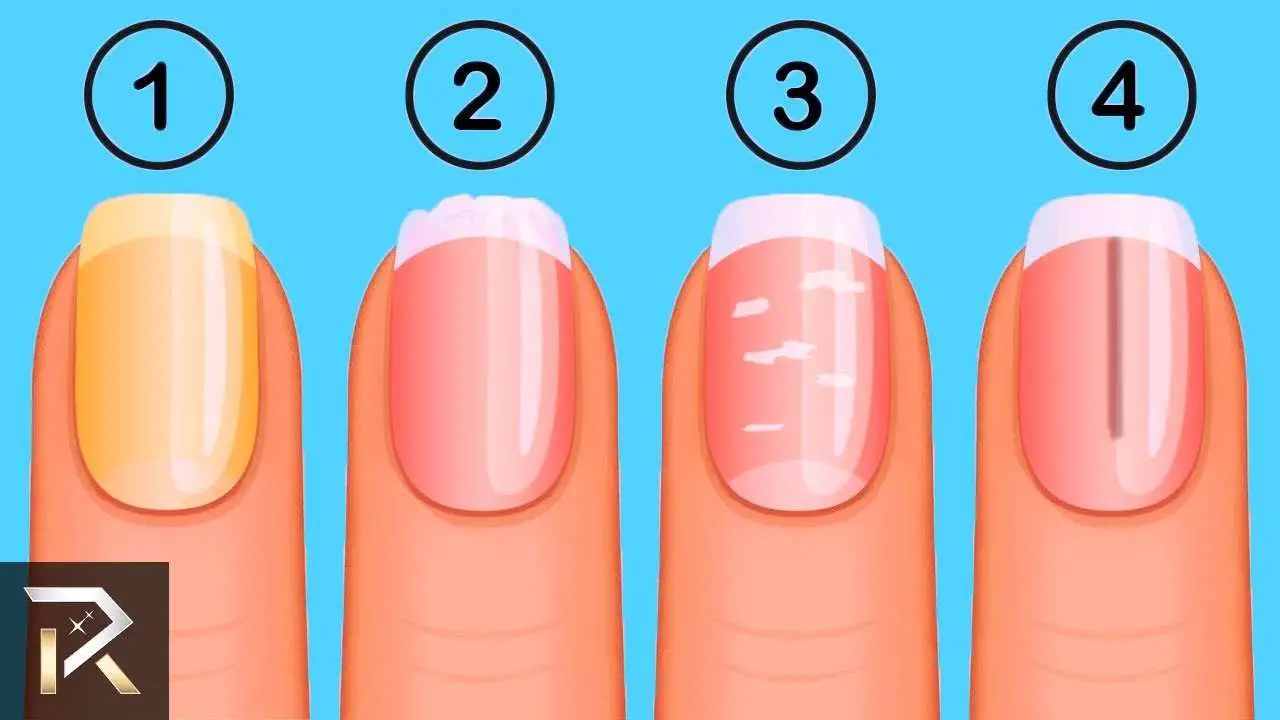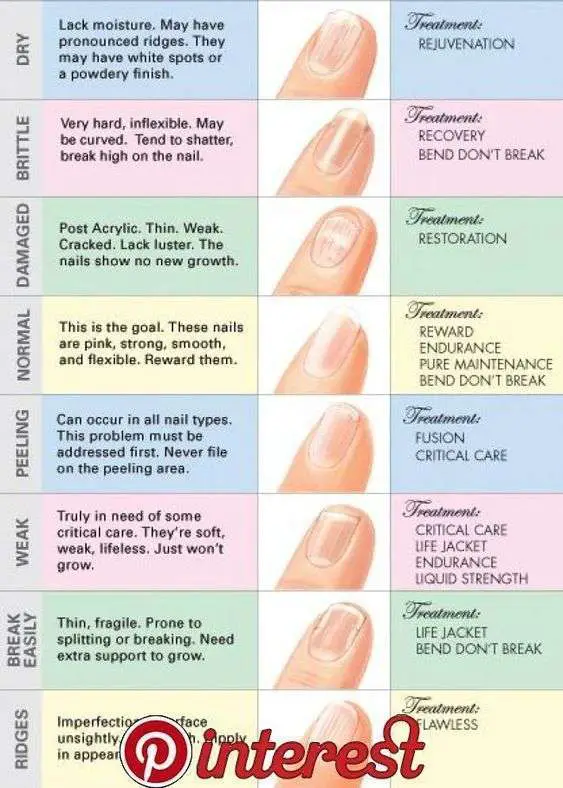Things Your Nails Can Tell You About Your Health
Those little white marks on your fingernails are trying to tell you something.
It may not seem like it, but a person’s nails can say a lot about their health. It’s true! A closer inspection at these tiny sheets of keratin can reveal everything from lung disease to allergies. Curious how you can use your fingernails and toenails as windows into your overall wellbeing? Keep reading to discover what your nails are trying to tell you about your general physical state. And for other wellness hints from your body, check out 13 Things Your Hair Is Trying to Tell You About Your Health.
Yellow Fingernails Could Be A Sign Of A Fungal Infection
If you have yellow spots under your nails or the whole nail has turned yellow, you may have a fungal infection. Known as onychomycosis, fungal nail infections can cause discoloration and thickening of the nails. They may also make them more brittle. Fungal infections are more common on toenails, but fingernails are not immune. The infection is caused by dermatophytes, a type of fungi that requires keratin in order to grow.
According to the Centers for Disease Control and Prevention , fungal nail infections can be hard to cure and usually require prescription oral antifungal medication. In very severe cases, a doctor may need to completely remove the affected nail. To prevent fungal infections, the CDC recommends keeping nails clean, dry, and well-trimmed. You should also avoid sharing nail clippers.
However, yellow nails aren’t always a health concern. Most often, they’re simply the result of the nail cosmetics we use. As Self explained, dark-colored polishes can stain nails yellow because the coloring agent in them reacts with the nail plate. The formaldehyde in nail polish can also react with the keratin in nails, turning them yellow and making them brittle.
You Have Athlete’s Foot
Athlete’s foot actually refers to two conditions: foot fungus and fungal toenail infections. The latter, which is most often picked up when walking barefoot in a communal area like a locker room, is characterized by ragged, yellow toenails.
Dermatologist Pamela Ng, MD, explained to the Mayo Clinic that in patients with immunodeficiencies, these fungal infections can cause “breakdown of the skin and lead to conditions like cellulitis or foot ulcers.”
Recommended Reading: Taking Off Contacts With Long Nails
Heavy Metals And Other Toxic Substances Can Affect Your Fingernails
According to the National Organization of Rare Disorders, inadvertent heavy-metal poisoning can occur either with a single high-dose exposure or, more commonly, through many low-level exposures that cause the metals to accumulate in the body over time. The metals most commonly associated with accidental poisoning are lead, mercury, arsenic, and cadmium. Even if you don’t work in industries that use these substances, you may still be exposed through pollution, contaminated food , drinking water from lead pipes or using cookware contaminated with lead, and accidental consumption of pesticides from unwashed produce.
Because most accidental poisoning happens gradually over time, nails may reveal clues that something’s going on before other symptoms appear. An article published in the Dermatology Times in 2014 noted that Mees’ lines on the nails can be a sign of heavy-metal poisoning. Also known as leukonychia striata, these bands of discoloration run horizontally across the nail. The article noted, however, that these lines may also appear because of a nail injury and in patients with kidney failure or undergoing chemotherapy.
The Problem: Severely Bitten Nails

Nail-biting is a common habit, but if it’s excessivesay, constant biting or picking at the skin around the nailsit could be a sign of obsessive-compulsive disorder. “Sometimes psychiatric medicine is required to treat OCD-related nail biting,” says Dr. Jaliman. “A bitter-tasting compound that’s polished onto the nails can help, too.”
Also Check: What Do Nail Techs Make
Your Thyroid Isn’t Functioning Properly
Your dry, brittle nails may not be your favorite thing to look at, but that doesn’t mean you should ignore them. According to the American Academy of Dermatology , “thick, dry, and brittle with visible ridges” can be a sign of thyroid disease. So, before you focus on your aesthetic problem, be sure to rule out this serious health issue.
Psoriasis Can Affect Your Fingernails
No one ever wants to lose a nail, but how the nail separates from the nail bed is a good indicator of why it fell off in the first place. Onycholysis is separation of the nail beginning at the fingertip end and working back toward the cuticle. Trauma to the nail is usually the cause of this relatively common form of nail shedding. But when the nail separates beginning at the cuticle side , psoriasis may be the cause.
Psoriasis is a common inflammatory condition in which an overactive immune system causes skin cells to regenerate faster than normal. According to the National Psoriasis Foundation, 30 percent of individuals with psoriasis also have psoriatic arthritis, in which the joints, tendons, and ligaments are affected by inflammation. A 2017 paper in the journal Reumatologia found that about half of individuals with psoriasis and 80 percent of people with psoriatic arthritis had associated nail issues. These issues can include pitting, changes in shape, thickening, and discoloration.
A 2017 paper published in the journal Cutis noted that once onychomadesis occurs, the nail or nails usually spontaneously begin to regrow within 12 weeks.
Don’t Miss: Soaking Dip Nails Off
White Spots On The Nails
For many people, a vitamin deficiency isnt uncommon, especially if nutrient-dense foods are lacking in a daily diet. But for anyone thats not getting enough zinc or calcium, a typical sign is white spots on the nails. Those white spots can begin appearing as soon as middle school age. However, an easy fix can be as simple as taking a zinc supplement of 30mg per day.
What Your Nails Can Tell You About Your Health
Visit a palm reader, and theyll appear to glean important info from scrutinizing your hand in search of the life, heart, head, and fate lines. Maybe this crease in the palm indicates luck, and that one reveals youre likely to find your true love and a fairytale happy ending.
The logically minded know all of this cant possibly be truebut its sure fun to imagine, isnt it? More likely, the mystic in question is just a keen observer. Noticing the wedding ring on your hand, she might tell you what you want to hear about your spouse, or, spotting the creases around your eyes, she might proclaim youve had a life filled with happiness.
But in reality, palm readers might do better by flipping over the hand and taking a look at the nails.
Anything going on inside your body will eventually appear on the outsideand your fingernails are a prime place for these changes to manifest. Thats not to say that one broken nail is cause for concern. Its big, dramatic changes you want to pay close attention to. Sudden changes on or around the nail beds might be the bodys way of sending you a message that a health issue is lurking below the surface. Between manicures , always take a look at your nails for any of the following signs.
You May Like: Does Hydrogen Peroxide Kill Nail Fungus
No Half Moons On Your Nails
Some people may not have the rounded curve at the base of their fingernails. The word fingernail moons have come from the Latin word lunula, which means little moons. If these curves are not present or have suddenly disappeared, it could be a sign of malnutrition, depression, and anaemia.
If you experience symptoms like dizziness, anxiety, sudden weight loss or gain, unusual cravings, and lightheadedness, you should see a doctor.
There’s Something Wrong With Your Liver
Conditions associated with the liverlike liver cirrhosis, hepatitis B, and hepatitis Chave all been known to cause fingernail health issues. One 2010 study published in The Journal of the European Academy of Dermatology and Venereology compared 100 patients with liver issues to 100 healthy subjects and found that 68 percent of subjects with liver problems had nail changes, compared to just 35 percent of those in the control group. Specifically, nail fungus was the most common issue seen in liver disease patients, followed by horizontal ridges and brittleness.
Read Also: Does Varisi Nail Solution Work
You Have A Skin Infection
Are your nail folds looking a little too puffy and red? If so, you may have an infection that needs treating. “The most common cause of nail fold inflammation is a skin infection from bacteria, viruses, or yeast,” according to Garrity. And for other things to look out for on your outer layer, check out 7 Signs Your Skin Is Trying to Tell You You Have Coronavirus.
The Anatomy Of The Nail:

New nail cells begin growing inside the matrix and push the old ones through your skin as they grow out. Healthy nails are uniform in color and texture without pits, grooves, spots, or discoloration. Although the size and shape of the nail bed and nail thickness varies from person to person, nails should be gently convex and extend outward off the tips of the fingers.
You May Like: How To Remove Contact Lenses With Nails
List Of Nail Abnormalities: Causes And Symptoms
Vertical ridges and brittle patches can develop due to aging or minor injuries. Other abnormalities, such as discoloration, spots, and nail separation, may develop as a result of infections, injuries, or some medications.
In many cases, the skin condition known as psoriasis causes nail abnormalities. An estimated 50 percent of people with psoriasis may have nail psoriasis.
Otherwise, trauma to the nail may lead to abnormalities that can result in discoloration, spots, or changes to the nail.
Changes in or around the fingernails and toenails can have many other causes, which we discuss below:
Nail abnormalities can be a sign of different conditions that need medical attention and treatment.
Many nail abnormalities are harmless while some are signs of health conditions.
They are usually not the first signs but one of many symptoms, so people should pay attention to all of their body cues rather than just their nails.
Consult a doctor if you are worried about any of the following symptoms of nail abnormalities:
- changes in nail shape, such as curling or clubbing
- discoloration, such as dark or white streaks, or other changes in color
- changes in thickness, such as thinning or thickening of nails
- brittle nails
Spooned Nails And Iron Deficiency
Most people associate iron deficiency with anemia and dizziness. But another telltale sign of low iron can be seen in the nails. Spooned nails are exactly as imagined: nails that are concave with the edges of the nails pushing outwards rather than hugging the finger as normal. Even though iron deficiency is usually the culprit, other factors such as heart disease or hypothyroidism could be causing the nail deformity.
Don’t Miss: How Do I Get Nail Polish Out Of Clothes
+ Things Your Toenails Are Trying To Tell You
Pink, blue, orange some people only pay enough attention to their toenails to pick a color of polish when they get a pedicure. But dont be so quick to cover those toenails until youve had a good look at them. Like your hair and your fingernails, your toenails can tell you things about your internal health that could save your life.
Clubbed toes
If you notice your toenails are rounded on the top and curve downward, it might be a sign of clubbed toes. The underlying causes of clubbed toes include lung disease, liver disorders, digestive problems, heart disease and certain infectious diseases. However, without other symptoms and especially if clubbed toes run in your family you likely have nothing to worry about.
Red streaks
Red streaks indicate that you might have a heart infection. Theyre caused by tiny blood clots damaging the veins that run under the toenail. People who have an existing heart condition especially those with a pacemaker are more at risk of infection of the heart. A red streak might also be a sign of trauma, but if you havent kicked anything or dropped something on an affected toe recently, check with your healthcare provider to rule out a heart condition.
Pitted nails
Spoon-shaped toenails
Yellow toenails
White toenails
Vertical dark line
Brittle nails
Have you ever experienced a problem with your toenails? Let us know in the comments below.
Nail Texture Changes Linked To Health Conditions
Apart from the odd bump or small lines, nails are normally fairly smooth. But a texture change can occur when theres a problem elsewhere in the body. The following conditions can cause nail texture changes:
Beaus Lines Beau’s lines are indentations in the nails that run across the nail, according to the Mayo Clinic. Conditions associated with Beau’s lines include diabetes and peripheral vascular disease, as well as scarlet fever, measles, mumps, and pneumonia. Beau’s lines can also be a sign of zinc deficiency.
Pitting Small, pinpoint depressions can appear in the nails when theres a problem in nail plate layering. These depressions can be shallow or deep, and are more common on fingernails than toenails, Anderson says. Pitting is seen in approximately 68 percent of people with psoriasis and nail changes, according to an article published in 2017 in the journal Reumatologia. Pitting can also appear with alopecia areata, eczema, and the autoimmune disease lichen planus.
Read Also: How To Remove Impress Nails
Fingernails Sound The Alarm For Health Concerns
People often look for more apparent symptoms of underlying health conditions like aches, pains, or bruises. But the fingernails can also serve as a sign that something might be wrong. Healthy nails should be smooth without discoloration. While deviations from the above arent automatically an indicator of an underlying problem, talking with a healthcare provider about any concerns is recommended.
Signs Of Abnormal Nails
- Thinning or thickening
- Oddly shaped
The good news is that nail changes arent usually anything to get riled up over. Even so, a change in appearance can sometimes point to a disease elsewhere in the body. If you notice any of the following changes in your nails, err on the side of caution and make an appointment to see a dermatologist or podiatrist.
Don’t Miss: How Much Does Nail School Cost
Nail Shape Changes Linked To Health Conditions
A wide range of health issues can also cause changes in the shape of your nails. Conditions possibly associated with these changes include:
Spoon Nails The nails are soft and look scooped out, like they can hold a drop of liquid, according to the Mayo Clinic. This can have a variety of causes, including iron deficiency anemia, hemochromatosis , hypothyroidism, and heart disease.
Clubbed Nails or Clubbing The tips of the fingers get larger, and the nails curve around the fingertips, according to the Mayo Clinic. Nail clubbing is most often associated with cardiovascular or pulmonary disease, such as chronic obstructive pulmonary disease and congestive heart failure, explains Anderson. Less common causes include inflammatory bowel disease and cirrhosis.
What Your Fingernails Can Tell You About Your Health

Just like the eyes are the window to the soul, so are the nails
This statement is credited to dermatologist, Tamara Lior according to a WebMDarticle who once convinced a patient to have his lungs checked after noticing a bluish tint to his nails, a sign that he wasnt getting enough oxygen. Sure enough, he had fluid in his lungs!
It thus seems like a lot can be said about our health status from a look at our nails. Hence, taking a good look at your fingernails may help you notice subtle changes in the texture or color a touch of white here, a rosy tinge there, perhaps some rippling or bumps in the surface. These imperfections may not look like much to you, but to the trained eye they can provide valuable clues about your overall health.
Take a look at some of such instances:
1. Pale Nails
Very pale nails can sometimes be a sign of serious illness, such as anaemia, congestive heart failure, liver disease, and malnutrition.
2. White Nails
3. Yellow Nails
4. Bluish Nails
5. Rippled Nails6. Cracked or Split Nails7. Puffy Nail Fold
Also Check: How To Remove Contact Lenses With Nails
Low Protein Levels In Your Blood May Show Up In Your Fingernails
In addition to color changes, lines and grooves on the nails can be a sign that something potentially serious is going on with your health. According to WebMD, Muehrcke’s lines are a double band of white lines that go across the nail and don’t grow out as the nail grows. The lines do not cause dents in the nail, and the nail bed underneath the nail is healthy. These lines may temporarily disappear when pressure is applied. They’re usually most clearly seen on the index, middle, and ring fingers and rarely visible on the thumb.
A 2018 paper published in the journal Autopsy & Case Reports explained that Muehrcke’s lines, named after the researcher who first documented them in 1956, are associated with hypoalbuminemia . Albumin is a protein found in blood plasma that helps maintain blood pressure and transports hormones and other substances throughout the body. Albumin levels below 3.4 g/dL are considered low. Causes of hypoalbuminemia include kidney damage, liver failure, too little protein intake, and inability to properly absorb protein. The paper noted that once albumin levels return to normal, Muehrcke’s lines disappear.
